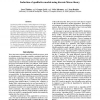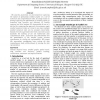AI
2011
Springer
14 years 2 months ago
2011
Springer
Qualitative models are often a useful abstraction of the physical world. Learning qualitative models from numerical data sible way to obtain such an abstraction. We present a new ...
PSD
2010
Springer
14 years 5 months ago
2010
Springer
Recently Sarathy and Muralidhar (2009) provided the first attempt at illustrating the implementation of differential privacy for numerical data. In this paper, we attempt to provid...
TVCG
2002
14 years 7 months ago
2002
Simple presentation graphics are intuitive and easy-to-use, but only show highly aggregated data. Bar charts, for example, only show a rather small number of data values and x-y-pl...
AAAI
1990
14 years 8 months ago
1990
Programs such as Bacon, Abacus, Coper, Kepler and others are designed to find functional relationships of scientific significance in numerical data without relying on the deep dom...
IDEAL
2000
Springer
14 years 11 months ago
2000
Springer
Generalization of the covariance concept is discussed for mixed categorical and numerical data. Gini's definition of variance for categorical data gives us a starting point to...
IV
2002
IEEE
15 years 8 days ago
2002
IEEE
We describe AudioCave, an environment for exploring the impact of spatialising sonified graphs on a set of numerical data comprehension tasks. Its design builds on findings regard...
ISDA
2006
IEEE
15 years 1 months ago
2006
IEEE
We present in this paper a modification of Lumer and Faieta’s algorithm for data clustering. This algorithm discovers automatically clusters in numerical data without prior kno...
INCDM
2007
Springer
15 years 1 months ago
2007
Springer
Abstract. Clustering algorithms for multidimensional numerical data must overcome special difficulties due to the irregularities of data distribution. We present a clustering algo...
WSOM
2009
Springer
15 years 1 months ago
2009
Springer
The complex phenomena of political science are typically studied using qualitative approach, potentially supported by hypothesisdriven statistical analysis of some numerical data. ...


